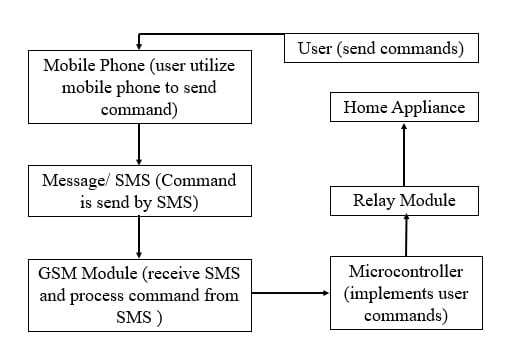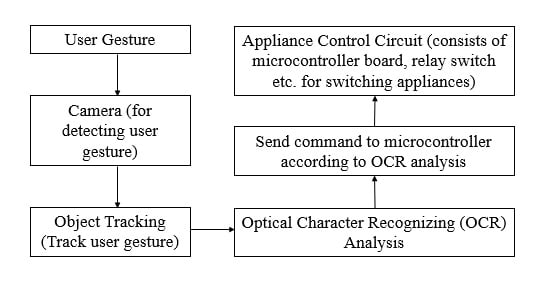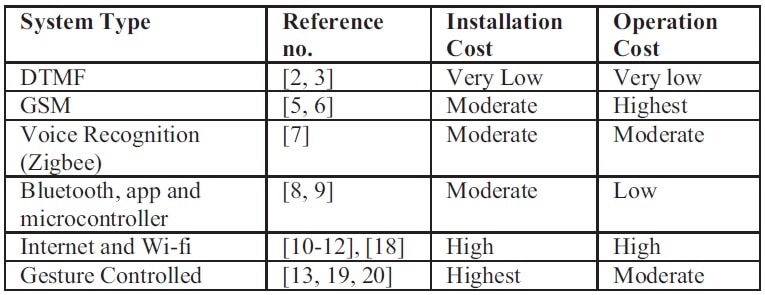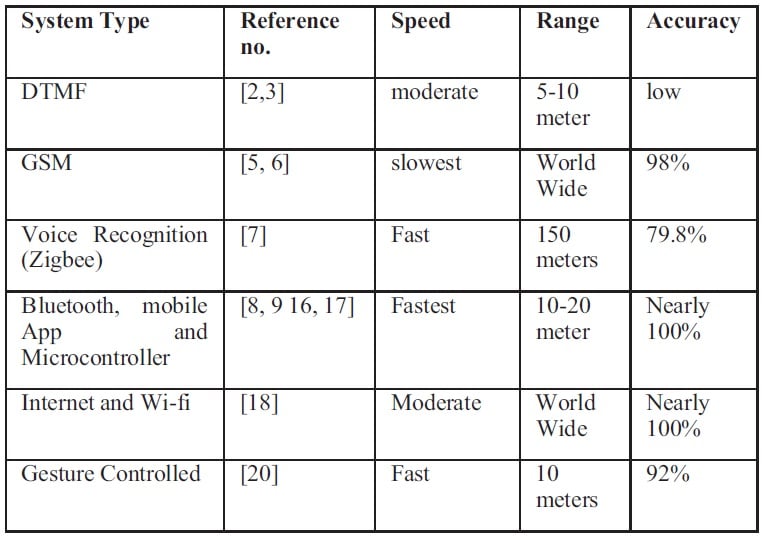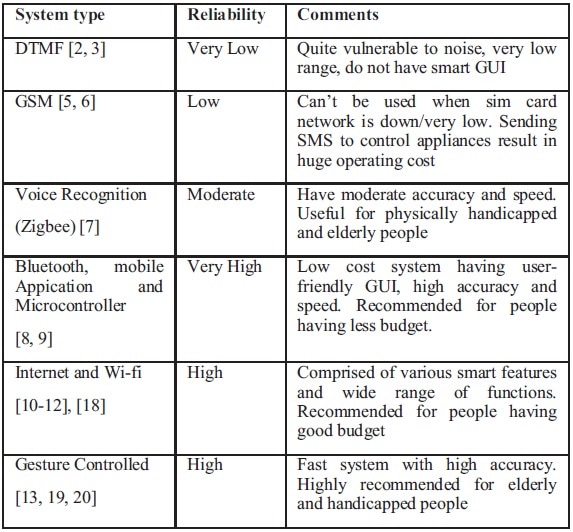Abstract
Smart Home Systems have achieved great interest in the recent years to make people’s life easier and more comfortable. Smart home system offers people to control home environment in efficient and comfortable manner. Technological advancement in recent years resulted in producing a large number of smart and sophisticated systems which promoted smart living technology. This paper presents complete analysis of various smart and intelligent home automation systems. Comparative analysis of existing smart home system has been made which provides a clear idea of the pros and cons of the existing systems. Working principle of different types of smart home systems such as Dual Tone Multi Frequency based, Global System for Mobile based, voice recognition based, Zigbee based, Bluetooth based, Internet and Wi-fi based, and Gesture based smart home systems has been studied. Comments according to different aspects and features have been made for the studied smart home systems which enable users to select suitable technology according to budget and needs.
INTRODUCTION
Smart Home System or Intelligent Home means automation and control of electrical appliance of our house. Recent technological advancement in electronic devices resulted in producing a huge number of user-friendly and flexible systems which promoted smart living technology. Domestic appliances can be remotely controlled by our electronic devices such as smart phones, Personal Device Assistant (PDA) and laptops which makes our life easier and comfortable. Smart Home System can be applied to control a great deal of activities in our home [1]. Depending on these activities, various sort of intelligent and automated systems has been developed. The idea of remote control of household appliances started with Dual Tone Multi Frequency (DTMF) based systems [2]-[3]. However, with the advancement of wireless technologies, the use of DTMF systems for SMS has been reduced by great deal. People nowadays find it easier to use systems comprised of user-friendly Graphical User Interface (GUI), wireless sensors and remote controlling devices. Recent smart phone technology allows researchers to develop such sort of flexible and user-friendly systems using smart phone application that has impressive GUI [4]. Recently, Global System for Mobile (GSM) communication has become a popular way of home automation [5]-[6]. Smart Home Systems based on voice recognition based control have gained a great importance for physically handicapped people [7]. Small and portable wireless electronic devices such as Bluetooth based smart home systems are also rapidly gaining importance which generally incorporates a microcontroller board to control household appliance [8]-[9]. The user sends the command to the microcontroller board using smart phone application. Internet has opened a new dimension in case of creating advanced and sophisticated Smart Home Systems [10]. Internet of Things (IoT) is playing an important role in making intelligent home automation systems which uses broadband internet connection to share information and data among the electronic devices and sensors [11]-[12]. Smart Home Systems are not only limited to internet based, smart phone based, GSM based and voice- recognition based systems. Many researchers are constantly working on gesture based home appliance automation system which allows user to control appliances using their different parts of the body [13]. Since different sorts of smart home systems have been developed over the years, it is necessary to have a complete overview and comparative analysis of these systems.
In this paper, a comparative analysis and discussion on various sort of smart home systems has been done. Moreover, Design and implementation methods of different smart home systems have been described. In addition, comparison of performance, cost and various other issues have been described so that users do not find it difficult to select their desired smart home system.
II. VARIOUS SMART HOME SYSTEM METHODOLOGIES AND THEIR WORKING PRINCIPLE
Depending on numerous functions, gadgets and hardware software combinations, popular Smart Home Systems are categorized into the following sub-sections.
A. Smart Home System Based on DTMF Technology
The idea of remote control of appliances in home environment began with DTMF tone by using mobile phone [2]. The system used specific signal from mobile phone digit to perform specific task. The signal generated from a DTMF keypad consists of two frequencies: column frequency and row frequency. The column frequency level is high and the row frequency level is low. The unique signal (tone) generated by the digit of a DTMF keypad enables the system to perform previously specified task automatically.
The system requires a mobile phone and a DTMF transmitter to send signal. The signal gets transmitted through a channel to the receiver. As the signal travels through the medium, it gets weak. So, the signal needs to be amplified before decoding. Therefore, the receiver circuit is followed by a condenser microphone and an amplifier. The signal is then decoded and send to microcontroller to perform its specified operation.
Fig. 1. Block diagram of smart home system based on DTMF technology
Fig. 2. Block diagram of smart home system based on GSM technology.
Fig. 3. Block diagram of smart home system based on voice recognition (ZigBee).
DTMF based home automation presented in [2] is vulnerable to noise. Hence, noise reduction is quite important in such kind of automation system to get rid of false data transfer which may result in false switching of appliances.
B. Smart Home System Based on GSM
GSM based home automation requires a mobile phone, GSM module, microcontroller board and control circuit to control appliances [5]-[6]. Commands are sent as SMS to GSM module which receives the message and send it to microcontroller board to implement the command. With the help of relay module, the microcontroller board turns on/off the specific appliances. In this way, remote switching of home appliances can be done using GSM module.
Smart Home presented in [5] achieved more than 98% accuracy and the entire processing of sending and receiving message (command) was done within 2 seconds. Smart Home based on GSM technology presented in [6] comprised of an LCD which displayed important messages. Moreover, it comprised of a smart app which provided flexible GUI to the user.
C. Smart Home System Based on Voice Recognition
In case of voice recognition-based automation, Zigbee based smart home systems are most popular [7]. Zigbee based systems can be divided into 3 major modules- microphone module, Zigbee coordinator (central controller) and Terminals (appliance controller). The system requires a smart phone/a desktop computer/ a smart Tablet/ a laptop which is connected to Zigbee coordinator module. The Zigbee coordinator module is branched into different terminals. The terminals can perform different specified task such as monitoring and control of temperature, gas, humidity, appliance switching and so on. To perform these tasks, different sort of sensors and appliance control circuit are needed to be installed. For voice recognition, ZigBee uses Microsoft Speech Application Programming Interface (API). RF Zigbee modules are being used for establishing wireless network. ZigBee based automated home presented in [14] achieved 79.8% accuracy for voice recognition.
Voice controlled Smart Home System was also developed using different method other than Zigbee [15]. The system in [15] used General Packet Radio Service (GPRS) technology. For speech recognition, Support Vector Machine (SVM) which is based on machine learning had been used.
D. Smart Home Based on Bluetooth Module, Smart Phone App and Microcontroller
This sort of smart home system is easy to install and operate. The system consists of a smart app with user-friendly and easy to use GUI, Bluetooth module to transfer command from smart phone to microcontroller board and appliance control circuit to control appliances [8]-[9].
Fig. 4. Block Diagram of Bluetooth, smart phone app and microcontroller based smart home system.
Fig. 5. Block diagram of Internet and Wi-fi based smart home system.
Fig. 6. Hand Gesture Based Smart Home System.
Smart phone application enables user to send command.
The commands get transmitted wirelessly from smart phone to Bluetooth module. The Bluetooth module transfers the command to a microcontroller board connected to it. The microcontroller board plays the role of central controller unit. Different sort of sensors having different functions can be incorporated with such sort of smart home system for different purposes which make this system versatile and compatible [16]-[17].
E. Smart Home System Based on Wi-fi and Internet
Home Automation System based on Internet is rapidly gaining importance due to its wide range of functions [10]- [12]. IoT Based Smart Home System developed in [12] incorporates smart control of lighting, intelligent appliance control, intrusion alarm system and gas/smoke detection.
Home appliance monitoring and controlling system based on IoT developed in [18] used smart phone, software app, controlling devices and micro web server. This system is divided into 3 major parts: remote environment, home gateway and home environment. For monitoring and controlling appliances remotely, remote environment is used. The system supports 3G and 4G internet, Wi-fi system and can be controlled by android app. The user sends command from android app which gets transferred through internet. The system is protected by firewall which ensures security. The data gets to the router through internet and then it gets transferred to ethernet shield. The home gateway provides data translation among internet, router and ethernet shield.
F. Gesture Controlled Smart Home System
Control of home appliances can be done by moving our body parts [13]. Such sort gesture based smart home systems are rapidly becoming popular. Hand gesture-controlled automation technique is most popular. Gesture controlled smart home systems generally requires a camera to record human gestures. Then, the images of gesture go through the process of image training. Based on a particular gesture, the system performs the pre-defined task.
III. PROS AND CONS DIFFERENT OF SMART HOME SYSTEMS
Different types of smart home systems have different advantages over the others. Some systems may appear quite user friendly, but have higher installation and operating cost. Response time of some smart home systems are fast, but have lower accuracy level. This section analyzes the pros and cons of different smart home system based on various aspects.
DTMF based Smart Home Systems are quite simple and easy to use [2]-[3] However, the system is vulnerable to noise which may result in false switching of appliances. Therefore, accuracy of DTMF based systems is not quite good. Moreover, the user does not receive any sort of feedback from the system.
Hence, the system is not quite user-friendly and reliable. GSM based smart home systems are more reliable and user friendly compared to DTMF based systems. GSM systems are comprised of user interface which make the system userfriendly [6]. The operating range of GSM systems is world wide. The user can control household appliance by sending SMS from any part of the world. However, sending SMS costs the user money and SMS cost depends on the global position of the user. If the user wants to control appliances from outside of his country boarder, SMS cost would be higher. Therefore, the operating cost of GSM based systems are higher. Moreover, the system is completely depended on mobile sim network. Hence, the system will not work properly if sim card network is down/very slow.
Voice recognition based smart home systems are quite easy to use. The user needs to send voice command to the system in order to control appliances [7], [15]. Such kind of smart home systems are quite useful for elderly and physically handicapped people. Processing speed of voice controlled smart home systems are also satisfactory. Installation cost of such kind of systems are also low since smart phones have built-in systems for voice recognition. Installation cost of Zigbee based voice controlled smart home systems are a bit higher than the other voice controlled smart home systems because it requires Zigbee protocols [7]. Operating range of voice controlled smart home systems can be 10-20 meters. But, Zigbee based systems can be stretched up-to a range of 150 meters. The major disadvantage of voice based smart home systems is accuracy. It is not possible for everyone to speak exactly in the same way which the systems can understand and process. Therefore, it is not possible for voice-controlled systems to process every command. Moreover, Signal- Noise Ratio (SNR) is quite important in case of accuracy of this sort of systems. As a result, accuracy of voice-controlled systems greatly decreases in noisy environments. Zigbee based system presented in [7] had an accuracy of 79.8%. Hence, the system is not reliable for all the cases.
Bluetooth based smart home systems are user friendly and easy to install [8]-[9]. Installation cost is low and operation cost is very low. Smart phone application allows user to easily control home appliances with just a touch from the smart phone. Accuracy level is very high and the system is quite fast. It only takes fraction of seconds to implement the command.
Hence the system is quite reliable due to its accuracy and speed. However, operating range of such kind of systems are around 10-20 meters which is the major disadvantage. Bluetooth based smart home systems are good choice for people having less budget.
IoT and Wi-fi based smart home systems are considered as most user friendly and flexible systems due to their wide range of smart functions and features [10]-[12], [18]. Due to internet, operating range is world-wide. However, due to complexity of functions and smart features, this sort of systems has very high initial cost. Moreover, due to usage of internet, operating cost is also high. This sort of smart home system is applicable for people having good budget for smart living.
Gesture controlled smart home systems requires complex coding to distinguish among numerous gestures [19]. This sort of system requires expensive hardware in addition to the appliance control circuit. For instance, hand gesture based smart home system presented in [20] requires camera to capture human gestures. Such kind of hardware adds extra cost towards installation. However, operating cost of gesture based systems are generally low. The major drawback of this sort of system is accuracy. Gesture might not be recognized by the system for certain cases. Gesture recognition accuracy for paper presented in [20] was 92%. Gesture based automation is greatly helpful for handicapped people.
IV. COMPARATIVE ANALYSIS AND DISCUSSION
A. Cost Analysis
Cost of smart home systems can be categorized into two parts: installation cost and operating cost. Installation and operating cost for DTMF based system is the lowest. Zigbee based systems have moderate cost. Gesture controlled and Internet controlled systems have comparative higher installation and operation cost compared to the other systems.
TABLE I. COST ANALYSIS OF SMART HOMES
B. Speed, Range and Accuracy Analysis
Performance of different smart home system according to speed, range of operation and accuracy are different. Analytical based comments on speed, range and accuracy of smart home systems are stated in Table II.
TABLE II. SPEED, RANGE AND ACCURACY ANALYSIS OF SMART HOME SYSTEMS
C. Reliability Analysis of Smart Home Systems
Based on different issues such as cost, range, speed, accuracy, flexibility, GUI and many other stuffs, it is important to determine whether a smart home system is reliable or not.
Reliability of smart home systems is quite important to determine because consumers need to have a clear idea of the product before buying it. According to our analysis, DTMF and GSM based home automation systems are found to be unreliable. Reliability of Smart Home Systems are listed in Table III.
TABLE III. RELIABILITY ANALYSIS OF SMART HOME SYSTEMS
V. CONCLUSION
In this research, an extensive study on various types of smart home system has been conducted and working principle of the smart home systems is clearly stated. Comparative analysis of smart home systems has been done to determine the pros and cons of different smart home system. Since there are numerous smart home technologies available in market, in quite necessary for users to have a strong guideline on different smart home systems so that the user can select the best type of system based on budget. Therefore, analysis on cost, speed, range, accuracy, complexity and reliability is quite important for users. This paper has clearly analyzed these issues for different sort of smart homes so that consumer find it easier to choose among various smart home methodologies. We believe that this paper will be greatly useful to consumers to buy their desired product and aid researchers to conduct further experiments on smart home technologies.



